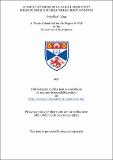Files in this item
Clinical studies using a high sensitivity shadow-shield mobile whole body monitor
Item metadata
| dc.contributor.advisor | Ritchie, Anthony Elliot | |
| dc.contributor.advisor | Boddy, Keith | |
| dc.contributor.author | King, Priscilla C. | |
| dc.coverage.spatial | ix, 115 p. | en_US |
| dc.date.accessioned | 2018-06-07T14:52:03Z | |
| dc.date.available | 2018-06-07T14:52:03Z | |
| dc.date.issued | 1971 | |
| dc.identifier.uri | https://hdl.handle.net/10023/13823 | |
| dc.description.abstract | This thesis describes research conducted by the author using a high sensitivity, shadow-shield, mobile, whole body monitor and is primarily concerned with its clinical applications. Whole body counting-rates vary when administered radioisotopes are redistributed in the body. Several methods of assessing the magnitude of geometrical variations in counting-rates have been brought together. Point sources in simple water phantoms, a life-like phantom man with simulated organs and human subjects were studied and the relative importance of the sources of variation and the value of the methods assessed. Cobalamin excretion rates were studied in patients with renal and hepatic disease from about one week after injection when, evidently the tracer dose of vitamin has effectively equilibrated with body stores. The daily cobalamin loss was abnormally high in 6 out of 8 patients with renal disease and 3 out of 6 with hepatic disease. In evaluating the treatment of vitamin B12 deficiency, the retention of three parenterally administered vitamin compounds was investigated. From the results, maintenance schedules could be derived empirically for patients with uncomplicated vitamin deficiency and with concomitant renal or hepatic disease. Using a double tracer technique, the oral absorption at different dose levels of coenzyme and other cobalamins was measured. The fraction of the dose absorbed appears to be a function of both the mass and the structure of the cobalamin. The human prostate gland contains a high concentration of zinc and when a carcinomatous change occurs in the gland, there is a distinct fall in the zinc content of the prostatic tissue. A preliminary study of the whole body metabolism and local prostatic uptake of zinc-65 was undertaken to provide the basis of a method for measuring the response of prostatic carcinoma to therapy. The metabolism of iron-59 was studied in an investigation of the anaemia in patients with chronic renal failure and in patients also receiving regular dialysis therapy. It was suggested that the anaemia results from the depression of erythropoiesis rather than iron deficiency. The high iron turnover rate in patients receiving regular dialysis could be explained almost entirely by the blood losses in the Kolff twin-coil artificial kidney. Methods of minimising these blood losses are suggested. The monitor was calibrated using potassium-42 for the measurement of total body potassium. The precision of the calibration and monitoring procedures were examined in detail, a relationship was derived enabling a calibration factor to be calculated from a subject's weight and height. In clinical practice, the measurement of total body potassium may only be meaningful if the 'normal' value is known; this was correlated with the weight, height and age of the subject. To illustrate these techniques, total body potassium was measured in an investigation of the potassium status in patients with chronic, renal failure, rheumatoid arthritis and following ureterosigmoid anastomoses. | en_US |
| dc.language.iso | en | en_US |
| dc.publisher | University of St Andrews | |
| dc.subject.lcc | QH324.K56 | |
| dc.subject.lcsh | Biomathematics | en |
| dc.title | Clinical studies using a high sensitivity shadow-shield mobile whole body monitor | en_US |
| dc.type | Thesis | en_US |
| dc.contributor.sponsor | Scottish Hospital Endowments Research Trust | en_US |
| dc.type.qualificationlevel | Doctoral | en_US |
| dc.type.qualificationname | PhD Doctor of Philosophy | en_US |
| dc.publisher.institution | The University of St Andrews | en_US |
This item appears in the following Collection(s)
Items in the St Andrews Research Repository are protected by copyright, with all rights reserved, unless otherwise indicated.

